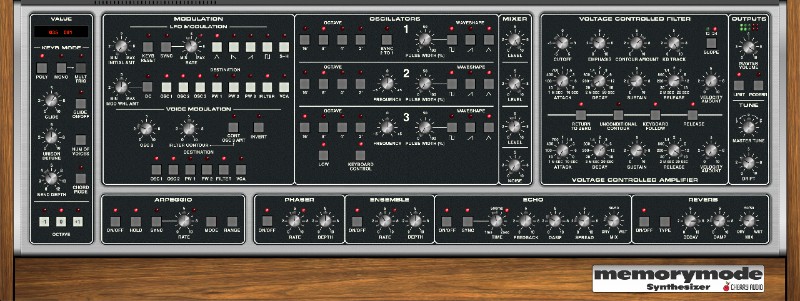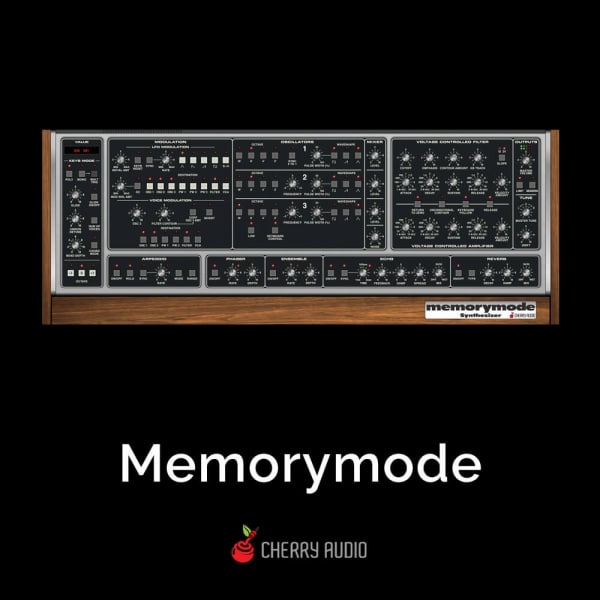Last Updated on February 28, 2023 by IDS Team
When looking for a moog synth vst, you can be spoiled for choice. In fact. we’ve previously covered a rundown of the best moog synth vsts out there. However, the Memorymode from Cherry Audio really deserves a mention, as it takes on the legacy of Moog’s polyphonic synths for one of the most inventive emulations yet. Read on for a look at how Memorymode replicates the legendary Memorymoog synthesizer of the 80s.
What is this moog synth vst inspired by?
The original Memorymoog synth was a lush, creamy polyphonic analog synthesizer. It appeared in 1982 and was made by Moog as they ventured into polyphony. The Memorymode does its best to faithfully emulate this as a vst plugin. The designers even went so far as to use a Memorymoog owned by jazz legend Chick Corea. The result is essentially a super high-quality digital Memorymoog – but even simpler to use.
The designers behind Memorymode make this vst equally exciting, as the team included Fleetwood Mac and The Cure collaborator David Polich, and naturally, as a vst, it doesn’t have the few issues with tuning that showed up on the original.
System Requirements:
To begin with, here’s a breakdown of what you need to run this fantastic plugin:
- Windows 7 and above 64-bit or Mac 10.13 or above 64-bit required
- also supports MacOS 13 Ventura
- both available in VST, VST3, AAX and standalone formats
- 8 GB Ram recommended
- Native Apple M1 and M1 Ultra supported
Availability: You can buy the Memorymode from Plugin Boutique, where it is currently on offer, by clicking this link. If you buy using our link, you will be helping our website since we get a small kickback. Thanks!
Memorymode: a moog synth vst that replicates the original
It’s fair to say that the Memorymode is a faithful emulation of the original. This goes right down to how the designers worked with a real Memorymoog to do this. But does it live up to this?
The Memorymode does a really good job at replicating everything that makes the Memorymoog so desired. That’s because the designers actually took the original factory preset patches of the Memorymoog and replicated them for the Memorymode. It doesn’t just provide a similar sound. It’s a Memorymoog for those who can’t get their hands on one, with additions.
The designers also clearly put a lot of thought into how to expand on the original. It uses the original ladder filter system but then adds touches like tempo sync on some of the FX for a modern feel. Then there are details like how the filters were replicas of the original Memorymoog. It shows, because the only noticeable differences in sound are ones you would expect from the fact it’s digital. Likewise, the only features they changed are to do with navigation. Here, they streamlined some of the input methods and introduced menus more suited to vst plugins. The vst has lost the original’s numerical keyboards, but its ease of use is second to none and it’s got some really cool updated features, as seen below:
Memorymode moog synth vst features:
- Three oscillators and ladder filter system of the original, 16 voice polyphony and single key chord memory
- 6 destinations for voice modulation
- 48 oscillator per key unison mode
- Repurposing of classic features for modern musicians. Notably: tempo sync on the LFO, delay, and arpeggio features (not featured on the original!)
- Moderniser features that touches up the sound to make it more contemporary (by altering the bass and high frequencies)
- Drift parameter – this is a really cool feature that allows you to alter the tuning. This can make your instrument sound ‘aged’ or ‘slack’, bringing real character that is sometimes hard to find with digital vsts.
- Phaser, echo, reverb, and stereo ensemble effects
- Full midi polyphonic expression capability (not possible with the original!)
- Midi control and daw automation
- Ultra-low CPU

Memorymode moog synth vst – what’s good about it?
Obviously one of the biggest upsides of the Memorymode is the price. It’s affordable for most musicians especially as secondhand Memorymoogs are expensive and disappear quickly.
The Memorymode was one of the last synths Moog designed before the company shut down. Now, it has a relatively legendary status for simply sounding great.
Such an accurate emulation shows that the people behind the Memorymode genuinely care about providing an alternative for fans. The Memorymode is not just taking a few bits of inspiration here and there. They nailed the things that make original Moog synths still so popular, but also introduced new additions which worked with what made the original great. For example, the Memorymode has the same overdrive when pushed that the original hardware synth did. Yet, the new FX also sound fantastic with it. Ultimately, it’s little features like this, that create the color that musicians loved.
This isn’t just a synth for hardcore Moog fans though. As a general vst plugin it stands up without having to attach itself to the legacy of its hardware counterpart. It just sounds great. You can hear the lush sounds that the Memorymoog became known for. The factory presets are fantastic too, so if you’re looking for a polyphonic synth plugin, it works well on its own accord.
Is there anything bad about the Memorymode?
There’s not much bad to say about the Memorymode, it does a really good replica of the Memorymoog and it ensures that the qualities that helped gain its original fans are here.
However, the only thing is that it doesn’t have a huge variety of sounds outside what you would consider ‘classic’ Moog features, but that’s to be expected. However, if you’re looking for a good replica or even deciding which moog synth vst to go for, this is a really good option. It gives you a great introduction to the typical Moog sound. Similarly, it has all the richness and character of the synth that it models.
You can buy the Memorymode from Plugin Boutique by clicking this link.
Final Thoughts
Ultimately there are very few bad things to say about the Memorymode – the fact that a replica of a great polyphonic Moog synth exists is just a start. However, the Memorymode also works because the synth it emulates was so great in the first place. Ultimately it’s really worth it as a moog vst plugin. Yet even for those who aren’t fans of these synths, the Memorymode is a great polyphonic synth vst for your setup.
Liked this? We have many more articles on music software, plus more on emulations of classic synths here too.



